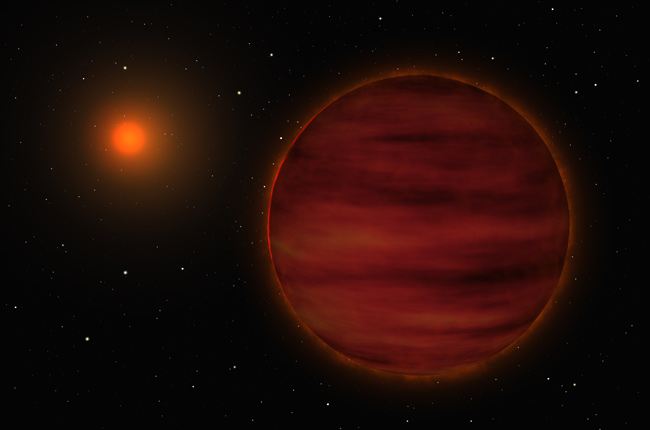Newly Discovered Failed Star Added to Stellar Neighborhood

A team ofastronomers has found a cold object that is neither star nor planet circling astar relatively close to Earth.
The object,a coolbrown dwarf orbiting its red parent star, sits about 12.7 light-years fromthe Sun, making it the third closest such object known to date, researcherssaid.
Cold anddim, browndwarfs are objects that are typically more massive than planets but fallshort of igniting into full-fledged stars. Astronomers using the Very LargeTelescope at European Southern Observatory in Paranal, Chile foundthe latest brown dwarf orbiting the red star SCR1845-6357.
"Besidesbeing extremelyclose to Earth, this object is a T dwarf--a very cool brown dwarf--and theonly such object found as a companion to a low-mass star," said Beth Biller,lead author of the study reporting brown dwarf find and a graduate student atthe University of Arizona, in a statement. "It is also likely the brightestknown object of its temperature because it is so close."
Thenewly found brown dwarf carries a temperature of about 1,382 degrees Fahrenheit(750 degrees Centigrade) and a mass between nine and 65 times that of Jupiter,researchers said. It also orbits its red parent at a distance 4.5 times that ofthe average separation between Earth and the Sun, or about 418 million miles(672 million kilometers), they added.
Theresearch will be detailed in an upcoming issue of the Astrophysical Journal.
Despitetheir proximity, the red star and brown dwarf observed by Biller and hercolleagues is not the closest to Earth. Twoothers have been found around the star Epsilon Indi, which sits about 11.8light-years from Earth. Anotherobject sits slightly further out, at a distance of about 13 light-years,followed by another brown dwarf 16 light-years from Earth.
Get the Space.com Newsletter
Breaking space news, the latest updates on rocket launches, skywatching events and more!
Onelight-year is the distance light travels in one year, about 5.88 trillion miles(9.7 trillion kilometers). The nearest star to Earth is ProximaCentauri 4.2-light-years away.
Billerand her team hope their brown dwarf will help astronomers better understand thecold objects that seem to occupy a purgatory between stellar and planetaryformation.
Lastyear, researchers found a brown dwarf surroundedby a disk of material, hinting that the odd objects could spawn their own system ofmini-worlds.
MarkusKasper, an ESO team member who participated in the recent brown dwarf study,said the new find allows astronomersto pin down the object's brightness and--after further observations--its precisemass.
"Theseproperties are vital for understanding the nature of brown dwarfs," Kaspersaid.
- Astronomers Claim Potential Mini Solar System
- Closest Failed Star to Earth Found to Have Failed Companion, Too
- New Neighbor May Be Closest Known Brown Dwarf
- When Stars Fail, Planets Might Still Succeed
Join our Space Forums to keep talking space on the latest missions, night sky and more! And if you have a news tip, correction or comment, let us know at: community@space.com.

Tariq is the Editor-in-Chief of Space.com and joined the team in 2001, first as an intern and staff writer, and later as an editor. He covers human spaceflight, exploration and space science, as well as skywatching and entertainment. He became Space.com's Managing Editor in 2009 and Editor-in-Chief in 2019. Before joining Space.com, Tariq was a staff reporter for The Los Angeles Times covering education and city beats in La Habra, Fullerton and Huntington Beach. In October 2022, Tariq received the Harry Kolcum Award for excellence in space reporting from the National Space Club Florida Committee. He is also an Eagle Scout (yes, he has the Space Exploration merit badge) and went to Space Camp four times as a kid and a fifth time as an adult. He has journalism degrees from the University of Southern California and New York University. You can find Tariq at Space.com and as the co-host to the This Week In Space podcast with space historian Rod Pyle on the TWiT network. To see his latest project, you can follow Tariq on Twitter @tariqjmalik.











